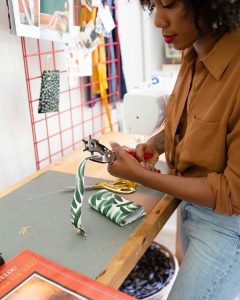R-KI-TEKT’s Eclectic Print-Covered Leather Accessories
Designer Kel Cadet-Lyons creates a variety of accessories inspired by different cultures

Atlanta-based designer Kel Cadet-Lyons produces artistic goods and accessories that range from leather wallets and booklets to planters and cord organizers. She releases each under her own label, R-KI-TEKT, an extension of a project she’d taken on for a former employer but expanded when demand grew. All of her releases live on Etsy, where acclaim in the form of reviews outnumbers her actual listings—a feat itself given the demand she keeps up with (see her shop’s temporary closure while she works to restock inventory, from 22 June through 1 July, as proof).

“I was working in a small boutique here in Atlanta, back in like 2009-ish,” Cadet-Lyons tells CH. There, her employer asked her to create an accessory like one that Cadet-Lyons had been wearing. “She was like, ‘Just put a couple in the store and see how they do,’ and they sold out. I made a couple more made out of recycled and vintage material, so they were limited. But once they sold out, she was like, ‘Well, you should make more things.’ From there, I just started making more hair accessories and then jewelry, and then wallets came kind of as an accident. I couldn’t find something that was slim and just simple and could go in my back pocket.”
Cadet-Lyons attributes motherhood—and the juggling of kids, their accessories, and her own—to her desire for a slimmer profiled wallet. But, she wasn’t set on choosing one that wasn’t an extension of who she was.

“I’m a mom, so I don’t like toting a whole of bunch of excess stuff with me. I just wanted to grab my phone, wallet, keys and put them in my back pocket,” she says. “I just started doing the envelope style and didn’t want it to be plain. I accidentally got some paint on some white leather, and I thought, ‘What can I make this into?’ to not waste it, and my first ‘Palm’ print came about. Then it all grew from there.”
That print—a leafy, plant-inspired design—marked her first entry into designing patterns. From there, she expanded her roster of self-made prints to include the Yoanhi, Suri, Adaora, and Karo. As for products, she fielded requests for new items—sunglasses cases, laptop sleeves, and the ilk—and worked them in as she could, with plenty more to come. The Yoahni, Adoara, Karo, Suri, and Palm prints offer adornment, but also much more. They’re inspired by Cadet-Lyons’ travels, African arts and culture, and joy—especially her own.

“They started as a freestyle, and I make them in batches,” she says. “Now, due to growth and how much I’m making them, I have to be a little bit more intentional so people can experience the full print.”
“They are all inspired by something or an experience. I’m West Indian, so I’ve seen color and pattern mixed in different ways my whole life—in unexpected ways that would not be considered traditional or easy on the eye, perhaps even haphazard. That and color therapy and color theory are the inspiration,” she says. “I also use a lot of the tribes in Africa—like the Suri print, which is named after the Suri Tribe. They are a very ornate people; they’ll take mud and berry juices and things of the earth and create pigment and paste for body adornment. Each one is so intricate and they’re usually spotted or mixed with their body scarification. Those little things that might, to the Western World, seem a little bit jarring to the eye or even painful I kind of used that as a print to be as seen as more beautiful.”

Each release’s beauty is balanced by its depth. These deeper meanings aren’t expressed through written statements or logos, but through Cadet-Lyons’ relaying of different cultures.
 “I think that it’s important to expose people to as much culture as possible without force feeding them—a meal is never served best when you’re forced to eat it,” she says. “Even naming the print the Suri, people don’t hear those names in their everyday conversations, and it might force them to research ‘What does Suri mean?’ Then they’ll discover these tribes in Africa that are forgotten, and they are definitely the inspiration for so much more that we’re not immediately aware of.”
“I think that it’s important to expose people to as much culture as possible without force feeding them—a meal is never served best when you’re forced to eat it,” she says. “Even naming the print the Suri, people don’t hear those names in their everyday conversations, and it might force them to research ‘What does Suri mean?’ Then they’ll discover these tribes in Africa that are forgotten, and they are definitely the inspiration for so much more that we’re not immediately aware of.”
“So, I try and pull from not just my personal upbringing, and living on the islands, and summering there, but things that I necessarily have not firsthand experienced, things I am more so attracted to. Things that people should know about because a lot of credit doesn’t go to the original source. Me naming these collections after those African tribes is my way of honoring them and thanking them for what they’ve given, even though they’re not always aware of it either.”
Images courtesy of Kel Cadet-Lyons












